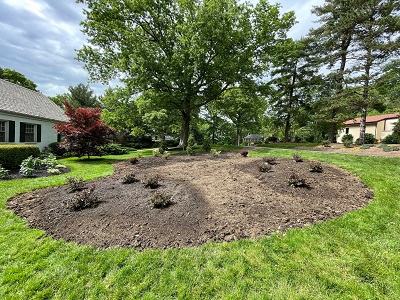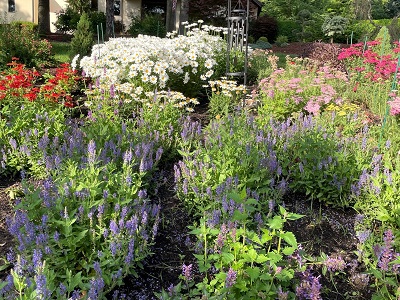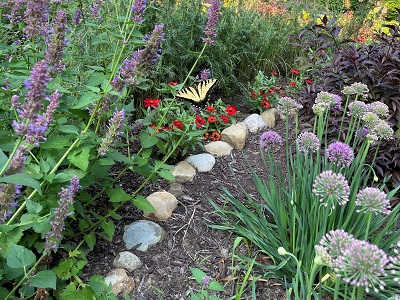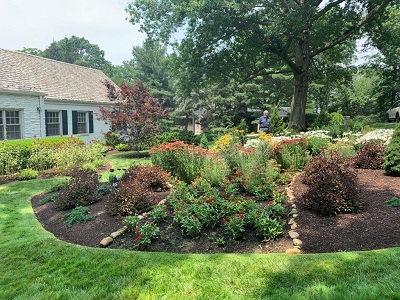Our Members Matter
Member Profiles
From Desert to Dessert: Pollinators Feast on Member’s Transformed Yard
Tom Hoffman’s yard is full of mature trees, but when a diseased large oak tree had to be taken down, he realized a substantial part of his front yard now received six or more hours of sunshine every day. The Conservancy member and volunteer knew that WPC and other organizations were raising awareness of the crisis facing pollinator species…so he decided to turn 1,500 square feet of his “great green desert” (his front lawn) into something more useful. 
He installed his first plants in May 2022. The photos shown in this article are the garden one year later. And here's a slideshow showing the progress of Tom's garden in 2024!
Tom shared this first-person explanation of the planning and planting process that transformed his yard into a buffet for bees, birds and butterflies.
I wanted to do my own design and layout, so I spent the winter of 2021-22 researching and planning. I had several criteria for the garden:
- it had to attract bees, butterflies, hummingbirds and other pollinators;
- the planting should have “cottage style” look;
- plants should add beauty to the front yard;
- it should have some evergreen shrubs and small trees for winter interest as well as shelter for the birds; and most important,

- it had to use plants that the deer wouldn’t eat!
Because this was a front yard project, it wasn’t possible to fence it off from the deer. There was no point in planting “deer candy” like hostas only to fight a losing battle. I only used plants my research suggested were “deer resistant.” Of course, deer will eat the chrome off a trailer hitch if they are hungry enough, but so far my strategy is working.
My pollinator flowers include: several types of spirea, cone flowers, Shasta daisies, perennial Salvia nemorosa, Agastache (hummingbird mint), several varieties of yarrow, annual zinnia, weigela, allium, tall sedum and deutzia, as well as bee balm plantings around the perimeter of the island. Right now (mid-August) the coneflowers, Agastache and Allium are covered with bees.
I did a lot of hand watering during the first year to ensure the new plants would survive. I didn’t lose a single plant over the winter, although it probably helped that the winter was mild.
I’m a rookie gardener, and there was a great temptation to bunch new plants together so things didn’t look too sparce. I’m glad I resisted that urge because the growth in just one year is astonishing. The garden is full, and now I’m beginning to wonder if I should expand it to accommodate more flowers.
Hummingbirds and finches come to the garden, as well as several species of bees, at least seven types of butterflies and several types of moths. I thought I was doing great attracting two or three types of bees, but, as I learned from a WPC webinar, “Pollinator Habitat: Plant It and They Will Come,” Pennsylvania has hundreds of bee species! Who knew?
I recently was researching ways to improve my bird baths when, to my surprise, I discovered that I also should build a butterfly puddle…one more thing I didn’t know. I’ve watched some videos, and I’m now trying to pick the best site to put in a puddling station.
As pleased as I am with the garden after one year, I know I have a lot to learn. I read as much as I can and attend workshops or online seminars — there are all sorts of pollinator programs for rookies like me. I always come away enthused but also humbled by how much there is to know and how little of it I know! I have great respect for master gardeners. And I admire the deep knowledge of the naturalists I’ve met at WPC.
It helps to be retired. I’ve spent a lot of hours getting the garden to this point. I don’t think I could have tackled this large a project if I were still working.
My current challenges are to learn about fertilization, pest control, soil improvement, plant division — all the stuff more seasoned gardeners know. I try to be as organic as I can. My bee balm struggled with powdery mildew this year, and I had to use a copper fungicide, but I use a natural, organic approach when I can.
Island plantings are interesting and challenging from an aesthetic viewpoint. Typically, home plantings are foundation or perimeter plantings, meaning you generally see them only from one or two angles because they’re up against a house or a fence. Garden advice on “what plant goes where” often is focused on foundation or border plantings. Islands, however, need to look cool from all directions. Mine is on a slight slope. It looks much different seen from the front window of my house, compared with how it looks from the street. I just love that about the island.
The biggest surprise for me was how much your senses come alive when you have to work with your face down near the flowers and shrubs. The smells, the feel, the activity going on in a garden — you miss that when you only look at a garden from a distance.
 One last thought: I wasn’t a gardener before I started this project. I was so nervous the day the landscaper came to cut out the grass and remember thinking, ‘What if I can’t do this?’ My wife, Karen, was very supportive. She said, “Well, if it doesn’t work you can always plant grass again.”
One last thought: I wasn’t a gardener before I started this project. I was so nervous the day the landscaper came to cut out the grass and remember thinking, ‘What if I can’t do this?’ My wife, Karen, was very supportive. She said, “Well, if it doesn’t work you can always plant grass again.”
But I was inspired by the work WPC and others were doing to help pollinators, so there was no going back. I read, planned, spent money, invested my time in the garden – and I took a chance. So far, I think the garden has been a success. And it’s hard to overstate the great feeling I get knowing that I am making a small contribution to the natural environment. If I can do it, you can too.

